One of the key goals of the 2030 Agenda is to “decouple economic growth from resource use and environmental degradation”.1 Sustainable consumption and production involves promotion of resource and energy efficiency as well as reduction of economic, social and environmental costs. These are intended to lead not only to sustainable development, but also improved economic competitiveness and poverty reduction.2 Given the population growth as well as improved living conditions in developing countries, individual prosperity and purchasing power increase pressure on already constrained natural resources. If current levels of lifestyle activities continue, by 2050 almost three planets will be necessary. Thus, both consumers and businesses are encouraged to take action in strengthening innovative production capacities, and reducing waste and individual consumption, respectively.3
Globally, there are eight targets and three means of implementation targets. While the countries have substantial control over some of the targets, particularly, 12.1, 12.A, 12.B and 12.C shall be achieved through joint cooperation between developing and development aid donor countries with developed countries being strongly encouraged to take the lead.
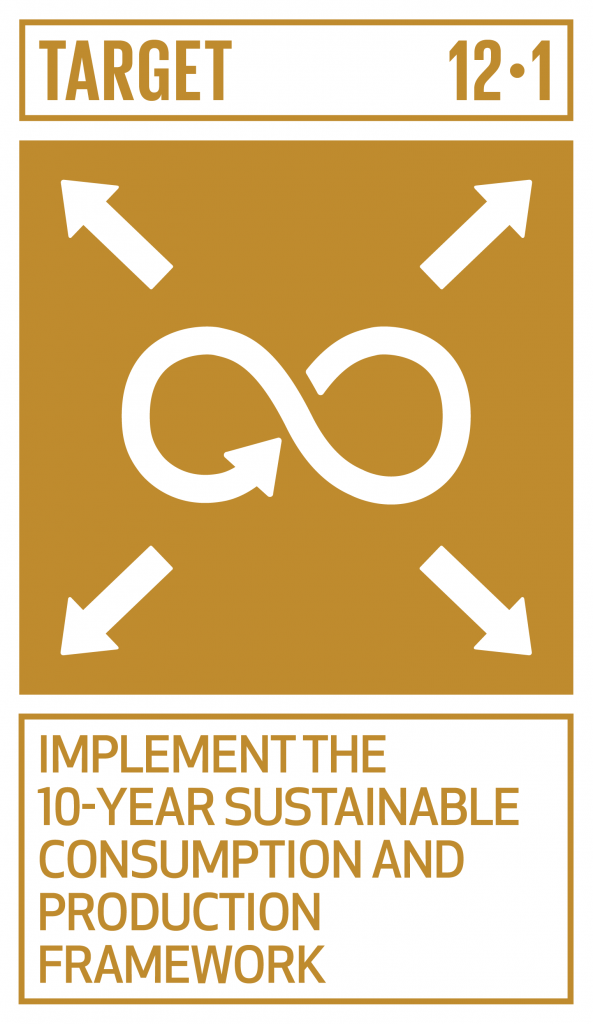 | 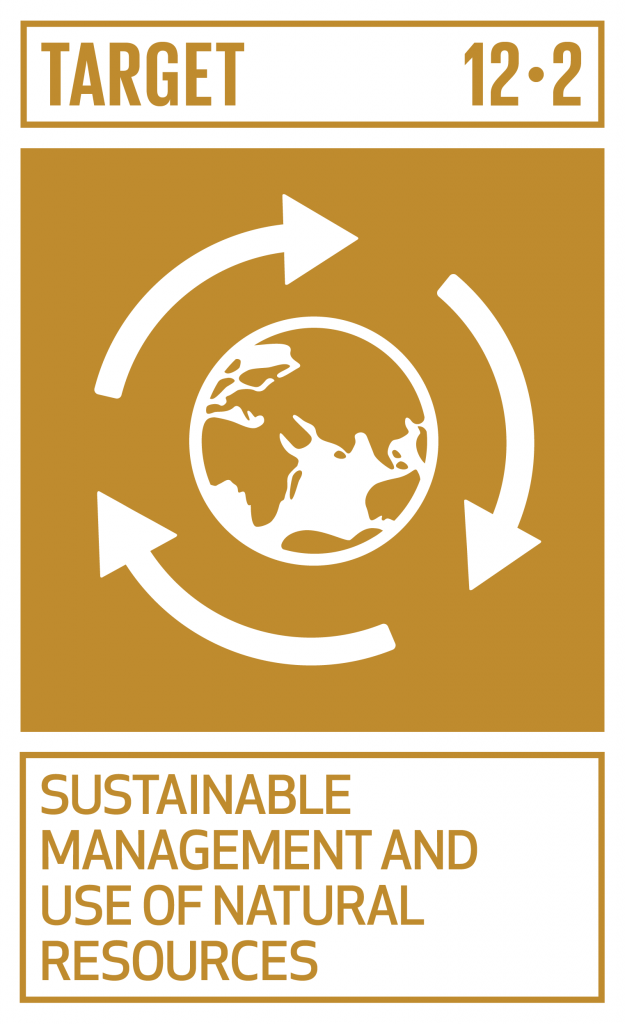 |  |
|
 | 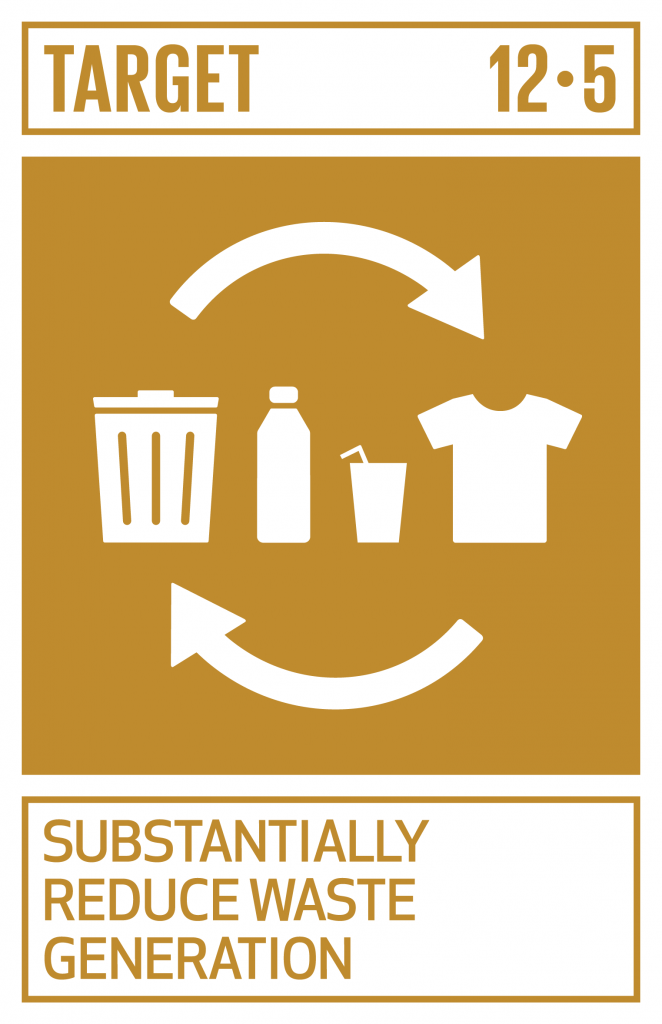 | 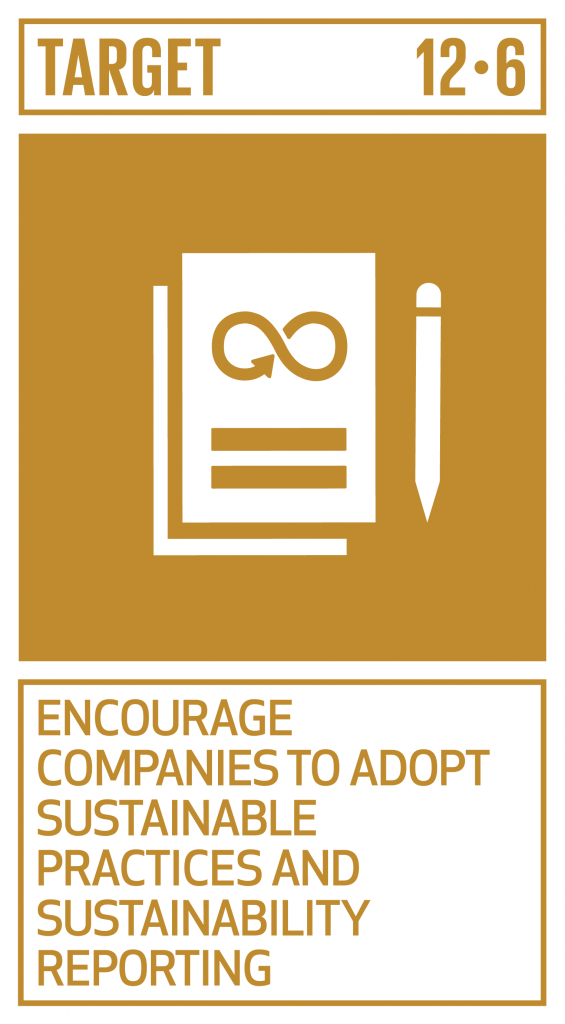 |  |
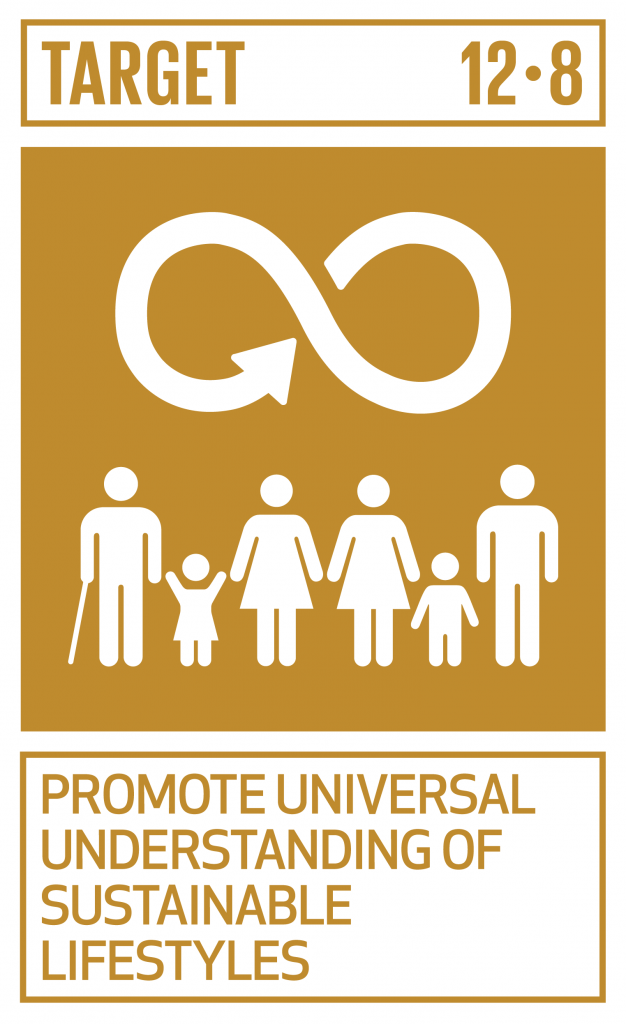 |  | 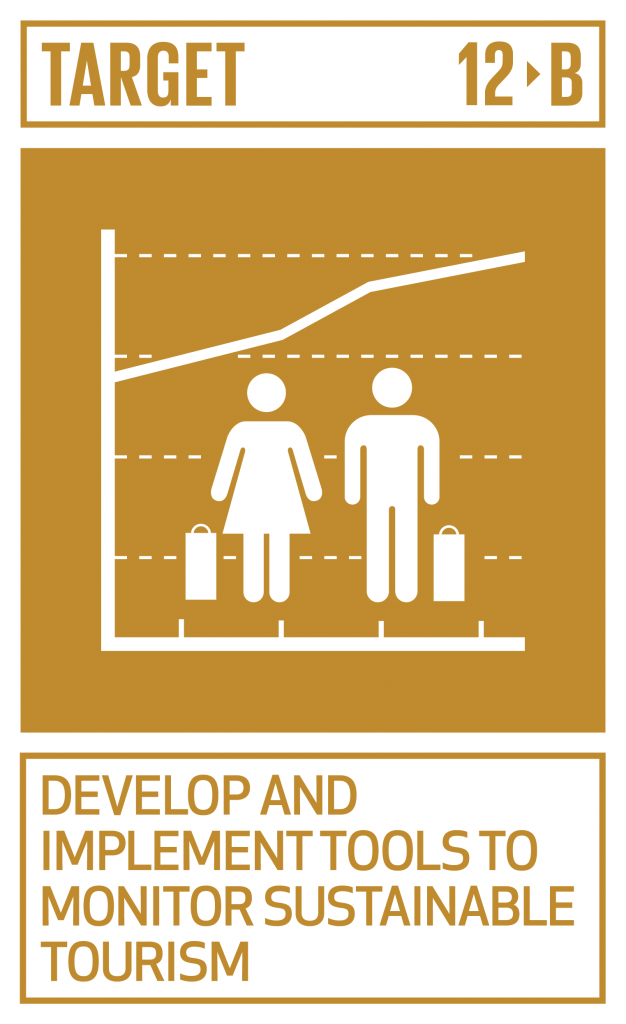 |  |
Transition from the MDG targets to SDG 12 in Cambodia
None of the Cambodian Millennium Development Goals (CMDGs), developed from the global Millennium Development Goals (MDGs), directly tackles sustainability of consumption and production. However, it is possible to see the similarities between CMDG 7 that aims at ensuring environmental stability and SDG 12.
CMDG 7 involves the following target 7.13“Integrate the principles of sustainable development into country policies and programmes and reverse the loss of environmental resources”, which technically corresponds to Target 12.1 of SDG 12. Yet, it is important to note that CMDG 7 sheds light on environmental resources, access to safe drinking water and sanitation as well as the proportion of urban/ rural population with access to land security, while SDG 12 reflects a need to protect environmental resources by efficient waste management and recycling. The most relevant indicator of CMDG 7 related to sustainable consumption and production, particularly domestic raw material consumption, is the overall wood fuel household dependency, where the objective was to cut down dependency on firewood by almost a half between 1993 and 2015
Table 1 CMDG7, Fuel Wood Dependency (% households)4
| Baseline | 2005 | 2010 | 2015 |
Fuel wood dependency | 92 | 70 | 61 | 52 |
However, according to Cambodia Demographic and Health Survey (CDHS), there were 84% households still dependent on firewood for cooking in 2005 going down to 79.5% in 2010. Overall, the population censuses show that domestic firewood dependency decreased from 90.4% to 83.6% between 1998 and 2008. These figures suggest the CMDG requirement of achieving 52% by 2015 was unlikely to be met. 5
Moreover, the statistics released by the Ministry of Mines and Energy of Cambodia provide evidence that final consumption of firewood, especially in residential rural areas, increased from 1,380,816 tons to 1,806,735 tons between 2007 and 2015. An increase in firewood consumption is equally observed in the industrial sector.6
The localization of SDG 12 in Cambodia
In localizing the SDGs, Cambodia has selected two out of the global SDG 12 targets corresponding to a total of four indicators, shown in the following table including the target values. The indicators are mostly related to pollution, waste management and recycling without any particular target or indicator addressing sustainable consumption.
Table 3 CSDG 12, Targets and Indicators
| Target | Indicator | Responsible Agency and Source of Data | Baseline (2015) | 2019 | 2020 | 2025 | 2029 |
| 12.4 By 2020, achieve the environmentally sound management of chemicals and wastes throughout their life cycle, in accordance with agreed international frameworks, and significantly reduce their release to air, water and soil in order to minimize their adverse impacts on human health and the environment | 12.4.1 Percentage of release reduction of Persistent Organic Pollutants (POPs) to the environment (%) |
| 0 | 2.0 | 5.0 | 10.0 | 15.0 |
| 12.4.2 Percentage of release reduction of mercury (Hg) to the environment (%) |
| 0 | 3.0 | 5.0 | 10.0 | 15.0 | |
| 12.4.3 Effectiveness management of hazardous waste and biological and radioactive waste (%) |
| 0 | 3.0 | 5.0 | 10.0 | 15.0 | |
| 12.5 By 2030, substantially reduce waste generation through prevention, reduction, recycling and reuse | 12.5.1 National recycling of materials used (1000 ton) |
| 163.0 | 178.1 | 180.0 | 210.0 | 240.0 |
Source: Royal Government of Cambodia,2018. “Cambodian Sustainable Development Goals (CSDGs) Framework (2016–2030)”– Part 2: target and indicator data schedules. Approved by Council of Ministers 19 November 2018. p. 38.
Generally, the Department of Pollution Control within MOE along with the Environment Departments of municipalities is responsible for waste management. Solid waste is categorized into household waste, commercial waste, industrial and hazardous including medical waste. 7 According to the 2017 UNDP report on management of mercury and hazardous waste, there was no proper facility for mercury/ hazardous waste management (transportation, recovery, treatment and disposal) operating in the country.8 Additionally, Green Growth Institute argues that actual figures on solid waste including hazardous waste remain largely unavailable and unharmonized.
The 2019 Environmental Management Plan released by the Ministry of Health calls for effective health care waste management that is also subject to target 12.4 and the corresponding indicator 12.4.3. Health care waste disposal remains one of the components of Cambodia Nutrition Project funded by World Bank.9 Around 10% to 25% of health care waste is classified as hazardous and poses potential health risks. Ministry of Health recognizes that weak management at health facility level hinders implementation of guidelines on health care waste management. A system has been established to safely collect sharp wastes from health care facilities for incineration, yet most incinerators are reported to be out of order.
Yet, gaps have been identified in areas beyond those chosen for localization by the RGC. In 2016, UNDP conducted a rapid integrated assessment of Cambodia’s National Strategic and Development Plan (NSDP) 2014-2018, providing a gap analysis of the SDG targets that are not or only partially addressed in the plan. UNDP notes that 82% of the targets related to environment pertaining to SDG 6, 12, 13, 14 and 15 are well addressed, yet important gaps are present. In respect to SDG 12, UNDP argues that targets such as 12.7 “Promote sustainable public procurement practices” and 12.3 “Halve global per capita food waste” are either not reflected in NSDP or seem to be less ambitious than the global SDGs. In particular, none of NSDP’s targets address reducing food waste at the consumer level10 Yet, according to the 2011 waste survey, food waste accounts for 70% of total solid waste in Phnom Penh, 71% in Battambang and 54% in Siem Reap.11 Based on the Ministry of Environment’s (MOE) estimates solid waste is increasing exponentially at a rate of approximately 10% a year due to rapid population growth and urbanization.12
Means of implementation for SDG 12 in Cambodia
None of the means of implementation targets 12.A to 12.C are directly addressed in CSDGs framework or policy papers. However, targets 12.4 and 12.5 are either directly or indirectly incorporated in numerous development plans published by the government agencies, NGOs or UN. Policies that address CSDG 12 and its targets include:
- National Strategic Development Plan (NSDP) 2014-2018
- Cambodia National Strategic Plan on Green Growth 2013–2030
- National Environment Strategy and Action Plan
- Waste Management Challenges in Cambodia and Experiences from other countries
- The Cambodia’s Priorities for GEF-6 under STAR-funding projects: National Project Prioritization
- Cambodia Nutrition Project: Environmental Management Plan
- National Strategy on Integrated Solid Waste Management (2011–2025)
Within NSDP 2014-2018, MOE is supposed to prepare the following legislations that may lead to successful implementation of the CSDG 1213:
- Develop a Law on the Management of Environmental Pollution
- Develop a Law on Environmental Impact Assessment
- Develop a Law on Chemicals Management
- Develop a Law on Minamata Convention on Mercury
- Develop a Sub-decree on the management of electric and electronic appliances within waste management
- Issue circular on scientific collection, transportation, recycling and disposal of solid waste and rubbish
Some of the CSDG targets are also incorporated into Cambodia’s priorities for the sixth replenishment period of the Global Environment Facility (GEF-6) under the System for Transparent Allocation of Resources (STAR) funding projects released by MOE for the period of 2015 to 2018.14 The projects related to Cambodia’s SDG targets include:
- Promoting Sound and Chemicals Management for Aquaculture Development in Cambodia
- Greening of Industries by improved technologies for reduction and management of unintentional POP’s release from kilns, dryers & furnaces and subsequent reduction in GHG emissions.
- POP’s PBDE Waste Management
- POPs Monitoring Programme
- Development of Minamata Initial Assessments in Asia (mercury-oriented)
Moreover, in respect of chemical waste management, the report notes that the “fragmentation of legislative coverage of numerous aspects of chemical management and the number of responsible government agencies in Cambodia indicates immense legislative coordination challenges.” In other words, uncoordinated actions of Cambodian authorities contribute to ineffective enforcement of the waste management laws, and results in collection of unharmonized and incompatible data.
Finally, regarding mercury waste management Cambodia has undertaken numerous activities under the fund through the United Nations Environment Programme/ Division of Technology, Industry and Economicy (UNEP/ DTIE) including:15
- Developed an Action Plan on the management of releasing of Mercury in Cambodia 2008-2010
- Conducted primary inventory on mercury release in Cambodia
- Developed Mercury waste Management Action Plan 2013-2017
- Developed Technical Guideline on Environment Sound Management of Mercury Waste
- Developed of Strategic plan on Management of Mercury in Artisanal and Small Scale Gold Mining 2012-2016
Monitoring SDG 12 in Cambodia
The Ministry of Environment has the overall responsibility for the national monitoring and evaluation of the SDG 12 targets in Cambodia, while agencies such as MIH, MAFF, MoI, MoH, MPWT, MoC and others are in charge of monitoring of specific indicators. Interestingly, there are three to seven different agencies responsible for monitoring as well as collecting data for each indicator within the CSDG targets, which may, as already argued in the previous subsection, lead to inefficiencies in environmental law enforcement and data standardization. (Refer to Table 3 for responsible agencies and source of data for each indicator.)
Related topics
References
- 1. United Nation. “Goal 12: Ensure sustainable consumption and production patterns”. Accessed on 02 July 2019
- 2. United Nations 2019. “SDG Tracker: Ensure Sustainable Consumption and Production Patterns”. Accessed 2 July 2019
- 3. United Nations 2019. “Responsible Consumption & Production: Why it matters”. Accessed 2 July 2019
- 4. Royal Government of Cambodia 2000. “Cambodia Millennium Development Goals”. Accessed 2 July 2019
- 5. Ministry of Planning, Royal Government of Cambodia 2013. “Annual Progress Report: Achieving Millennium Development Goals”. Accessed 2 July 2019
- 6. General Department of Energy and General Department of Petroleum, Ministry of Mines and Energy of Cambodia 2016. “Cambodia National Energy Statistics 2016”. Accessed 3 July 2019
- 7. Royal Government of Cambodia 2016. “National Environment Strategy and Action Plan 2016-2023”. Accessed 3 July 2019
- 8. Global Green Growth Institute 2018. “Green Growth Potential Assessment: Cambodia Country Report”. Accessed 4 July 2019
- 9. UNEP 2017. “Regional Study on Mercury: Waste Management in the ASEAN Countries”. Accessed on 4 July 2019
- 10. General Department of Energy and General Department of Petroleum, Ministry of Mines and Energy of Cambodia 2016. ”Cambodia National Energy Statistics 2016”. Accessed 3 July 2019
- 11. UNDP 2016. “Rapid Integrated Assessment – Cambodia SDG Profile”. Accessed 3 July 2019
- 12. Cambodian Education and Waste Management Organization 2011. “Waste Survey/ Research”. Accessed 2 July 2019
- 13. Royal Government of Cambodia (RGC). “National Strategic Development Plan 2014-2018”. Chp 4, p 137. Accessed on 3 July 2019
- 14. Ministry of Environment 2015. “The Cambodia’s Priorities for GEF-6 under STAR-funding projects: National Project Prioritization (January 2015 – December 2018)”. Accessed 4 July 2019
- 15. UNEP 2017. “Regional Study on Mercury: Waste Management in the ASEAN Countries”. Accessed on 4 July 2019

